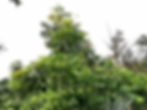Markhamia lutea: The Nile Tulip Tree - Uses, Benefits & Growing Guide
- BeyondForest
- Oct 10, 2024
- 5 min read
Updated: Oct 13

By the end of this section you will have learnt
0.)About the Markhamia Lutea
1.)Markhamia Lutea Common names
2.)FAQ About Markhamia Lutea
3.)Markhamia Lutea Seedling Prices
4.)Where to Buy Markhamia Lutea
5.)Markhamai Lutea Leaves
7.)Markhamia Lutea Seeds and Fruits
8.)Growth Conditions for Markhamai Lutea
Coffee doesn’t like too much sun or strong winds. Markhamia gives light, filtered shade and acts as a windbreaker and protecting coffee flowers and leaves which are delicate
Markhamia lutea, commonly known as the Siala Tree or the Nile Tulip, is a flowering plant belonging to the Bignoniaceae family.The Markhamia Lutea is native to tropical regions of Africa commonly found in countries such as Uganda, Kenya, and Tanzania .

Image of Markhamia Lutea seedlings
Markhamia Lutea is known for its vibrant yellow flowers and large, broad leaves. The Siala tree typically grows in savanna and woodland habitats . Markhamia was named in the honour of Clements Markham (1830-1916) who was an English geographer, explorer and writer and worked in India. Markhamia lutea can grow between 10 to 20 meters tall. Its crown is broad and rounded, providing ample shade and habitat for various fauna.

Image of the Siala Tree Fruits
Markhamia Lutea is known as Musambya tree in Buganda. In Kamba language it is Known as muumo. In Kiswahili language it is Known as muu or msasa. In Kalenjin language it is referred to as tendeet. In Luhya it is referred to as Zisiola Tree. In rwanda it is referred to as Umusave Tree

Markhamia Lutea is used in coffee plantations as it provides numerous benefits to the coffee by protecting the coffee flowers and leaves for shade at the same time while shedding leaves the leaves act as manure and compost to the trees.
Markhamia Lutea is known as Muu in Swahili language
Markhamia lutea is a fast-growing, evergreen tree with glossy compound leaves and striking yellow trumpet-shaped flowers. It typically grows 10–15 meters tall, has a straight trunk, and a rounded crown. The tree is drought-tolerant, attracts pollinators, and thrives in tropical climates with well-drained soils.

Musyamba tree is a common name of the Markhamia Lutea Tree in Buganda language in Rwanda the Markhamia Lutea is known as Umusave Tree
What is the use of the markhamia tree?
The Markhamia lutea tree is used for ornamental landscaping, timber, firewood, and traditional medicine. Its fast growth makes it ideal for agroforestry, soil erosion control, and windbreaks. The wood is used for furniture and poles, while flowers attract pollinators, enhancing biodiversity in farming and urban environments.

Image of a Markhamia Lutea Sapling by Uganda Environmental Conservationists Organization
The cost of Markhamia Lutea Seedling according to various Vendors ranges from 3Ksh to 220Ksh. The cost of the seedling depends with the size as the bigger the size the pricy it gets due to cost such as watering , root pruning and transferring to different pot sizes
Davis Mugera | 0722362981 |
Tree Tory Nursery | 0758637333 |

Image of the Nile Tulip Leaves
The leaves are compound and pinnate, with 3–7 leaflets per leaf. They are dark green, glossy, and slightly leathery, offering a lush appearance year-round.
Nile Tulip Flowers

Image of a Nile Tulip flower along Garden Estate In Nairobi
The tree is especially admired for its bright yellow, trumpet-shaped flowers that resemble those of the African tulip tree (Spathodea campanulata), though Markhamia is generally considered more manageable in size. Flowers appear in large terminal clusters and bloom mainly during the dry season, attracting bees, butterflies, and birds.

Image of Markhamia Lutea fruits
The fruit is a long, slender capsule that splits open when dry to release numerous winged seeds. These are dispersed by wind, allowing the tree to colonize open areas quickly.
Markhamia Lutea roots grow deep thus does not compete with neighboring crops such as coffee

Image of leaves of a Markhamia Lutea
One of the most distinguishing features of the siala tree is its large, trumpet-shaped flowers, which bloom in clusters.
The Markhamia lutea seeds with Just 1.5 kg can produce up to 20,000 seedlings.

Image of a Markhamia Lutea Flower
The flowers are usually a bright yellow color, with a fragrant scent that attracts a variety of pollinators, including bees and butterflies. Each flower measures approximately 5-10 cm in length.

Image of the Nile Tulip Flowers
The tree produces elongated, cylindrical pods that can grow up to 30 cm long, containing flat, winged seeds. These pods can be found hanging from the branches, adding to the tree's ornamental value

Image of Markhamia Lutea seeds
Growth Conditions for the Markhamia Lutea

Image of a Mature Nile Tulip Tree by David Okwii
Markhamia lutea thrives in tropical climates with moderate to high rainfall (800–2000 mm annually) and altitudes ranging from 1000 to 2400 meters above sea level. It prefers well-drained soils and can tolerate both acidic and slightly alkaline conditions.
Markhamia Lutea Leaves are organic fertilizer as the leaves fall, decompose, and feed the soil thus fertilizing the soil naturally
Propagation
Propagation is primarily done through seeds, which have high germination rates and do not require pretreatment. Germination typically occurs within 7–14 days. The tree can also be propagated from cuttings, though with slightly lower success rates.
Planting and Spacing
For optimal growth, seedlings should be spaced about 3–4 meters apart. Young trees require regular watering and weeding until established, after which they are relatively drought-tolerant.
Growth Rate
The tree grows rapidly, often reaching 3–4 meters in the first year under good conditions. It achieves full height in about 5–7 years, making it suitable for fast landscaping or soil rehabilitation projects.
Benefits of the Markhamia Lutea

Image of Markhamia Lutea seedlings
Timber Production
The wood of Markhamia lutea is valued for its strength and durability. It is commonly used in furniture making, construction, and crafting of various wooden products. The wood's light color and attractive grain make it desirable for both structural and decorative purposes.
Ornamental and Landscaping
With its striking yellow flowers and attractive foliage, Markhamia lutea is popular in landscaping and urban forestry. It enhances aesthetic appeal in parks, gardens, and public spaces, contributing to tourism and local economies.
Traditional Medicine

Various parts of the tree are used in traditional medicine. The bark and leaves are believed to have antimicrobial and anti-inflammatory properties and are sometimes used to treat coughs, wounds, and other ailments. However, scientific validation of these claims is limited.
Markhamia lutea can be integrated into agroforestry systems. Its ability to improve soil quality and provide shade makes it suitable for intercropping with cash crops, thus enhancing overall agricultural productivity and sustainability.
Carbon Sequestration
As a tree species, Markhamia lutea plays a role in carbon sequestration, helping to mitigate climate change. The cultivation of this tree can contribute to carbon credits and environmental sustainability initiatives.
Seed Production
The seeds of Markhamia lutea can be harvested and sold for propagation, offering an additional income source for farmers and entrepreneurs involved in horticulture.
The leaf litter from Markhamia lutea enhances soil quality by adding organic matter, which improves soil structure and fertility. This is beneficial for surrounding plants and agricultural activities.

Shade and Shelter
The broad canopy of the siala tree offers shade and shelter for smaller plants and animals, creating a microhabitat that supports diverse life forms.

